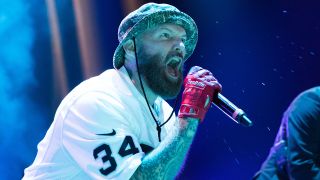
GRUNGE PHOTO EXHIBIT FEATURING NIRVANA, SOUNDGARDEN, PEARL JAM, AND ALICE IN CHAINS. CLICK TO VIEW
Rare recording of unreleased Green Day track “Stay” surfaces from 1989 gig: Stream
The dust dates back to when the band was opening for Killdozer at Berkeley Square

You can stream the track and consult the show’s setlist for context below. If that’s not enough, revisit our recent episode of Album of the Week in which host DC Hendrix and writer Kayleigh Hughes discuss the ensuing legacy of Dookie.
After that, you’ll probably wanna grab some Green Day vinyl over at ReverbLP.
Setlist:
Sweet Children
I Want to Be Alone
Going to Pasalacqua
The One I Want
16
Knowledge
Don’t Leave Me
I Was There
Jennifer (Unofficial title; only known performance)
1000 Hours
Green Day
At the Library
Disappearing Boy
Stay
Maybe Forever (Unofficial title; only known performance)
Dry Ice
25 YEARS AGO: NINE INCH NAILS GET DARK ON ‘THE DOWNWARD SPIRAL’
The alt-rock revolution was already in full swing when Nine Inch Nails released their second album, The Downward Spiral, on March 8, 1994.
Trent Reznor‘s virtual one-man band had actually beat many of its contemporaries there five years earlier, when Pretty Hate Machine came out. But the atmosphere was different now, more open to and embracing of music that didn’t play by pop’s old rules. And the music itself was different too, generally more guitars and less melody. The Downward Spiral was something entirely different than all of that.
When Reznor released Pretty Hate Machine in 1989, synth-pop was pretty much at the end of its decade-dominating rope. Early-MTV artists opened U.S. shores and ears to rock music that wasn’t played primarily on guitars, but by the end of the ’80s, a left-of-the-dial culture had sprung up that celebrated those dusty guitars – albeit with just a fraction of the machismo and obnoxious behavior that pretty much had run its course by the end of the ’70s.
Nine Inch Nails weren’t totally new. Ministry, Nitzer Ebb and Skinny Puppy were doing similar things in other parts of the world (Nitzer Ebb were from the U.K., Skinny Puppy came from Canada; Chicago’s Ministry were a little closer to Nine Inch Nails’ Cleveland home). And Pretty Hate Machine wasn’t all that original. But it was invigorating, inviting to a point and, most of all, catchy. Beneath all the industrial racket were some real songs.
With The Downward Spiral, Reznor carried the band into the ’90s with a new sense of purpose. The music was still industrial and still harsh – even more so, in fact. But alt-rock – spurred by Nirvana and now the biggest music to take over radio and record stores in years – was picking up more traction until it all bottomed out by 1997. So there’s that too. More significantly, The Downward Spiral – with its hour-plus length, densely textured tracks and thematic links among the songs – was almost, gulp, a prog record at heart.
Work began on the album soon after Nine Inch Nails played the first Lollapalooza tour in 1991. Reznor was going through a mess of personal issues ranging from substance abuse to depression to battling his record company, and worked them out on the sprawling album, which included 14 songs over 65 minutes.
Watch Nine Inch Nails’ ‘Closer’ Video
He focused on a character, not unlike himself, who struggles with various issues and often finds solace in sex, drugs, self-harm and suicidal thoughts. Bigger themes (including violence and religion) combine and collide throughout the work, as Reznor – once again working mostly alone in the studio – wrangled everything from industrial and metal to electronic and alt-rock into the musical mix.
There’s a trajectory here from the opening “Mr. Self Destruct” to the closing “Hurt.” In between, there’s “Piggy” (which introduces the musical theme that’s woven throughout), the frenetic “March of the Pigs” and “Closer,” which almost cracked the Top 40 (even with its notorious “I want to fuck you like an animal” refrain) and freaked the hell out of a whole lot of people with its disorienting video.
It all adds up to one of the era’s greatest and most defining albums, a record that crafted art out of pain, misery and music that sounded like it was made in the depths of a forgotten Rust Belt factory briefly fired up for one last job. Its influence over the next decade and beyond is great.
For starters, Johnny Cash rewired “Hurt” in 2002 for a poignant reading and an accompanying video that served as an early requiem for the legend’s death the following year. On a broader scale, The Downward Spiral – which arrived about a month before Kurt Cobain died – covered mental health, depression, suicide and other rarely discussed topics at a time when popular music, even on the alternative end of things, mostly stayed away from such issues.
That Reznor wrapped them all up in an artful package that unwinds over the course of an hour may be his and Nine Inch Nails’ greatest achievement. Punk and post-punk music were supposed to demolish the pomp and circumstance that came with so much prog music; The Downward Spiral essentially blurred the line between them, finding common ground in the artist’s personal vision.
Nine Inch Nails’ next album, 1999’s The Fragile, went even deeper, spreading its narrative concept and new-school prog-like musical themes over two discs. But The Downward Spiral is tighter, more focused and the more significant work. It’s unfathomable that a record like this could have reached No. 2, as Spiral did, even a few years earlier. There was a brand new and open field for artists and listeners during this fertile period. This landmark LP remains a singular work of the era, one that helped shape things to come.
Watch Limp Bizkit hook up with Marilyn Manson and Billy Corgan at $3 show

On Tuesday night, Limp Bizkit gathered at the Troubadour in Hollywood for a special show.
Fred Durst, Wes Borland, DJ Lethal, John Otto and Sam Rivers reunited onstage for the first time since 2012 for the set, which was billed under the Three Dollar Show, Y’all – a nod to the band’s 1997 debut album – and charged fans just $3 to get in.
Footage from the night has now emerged online, which shows vocalist Durst on the balcony with a couple of familiar faces: Marilyn Manson and Billy Corgan from Smashing Pumpkins during My Way.
Watch some of the footage below.
In November last year, guitarist Wes Borland reported that Limp Bizkit were preparing to return to the studio to work on the long-awaited follow-up to 2011’s Gold Cobra.









